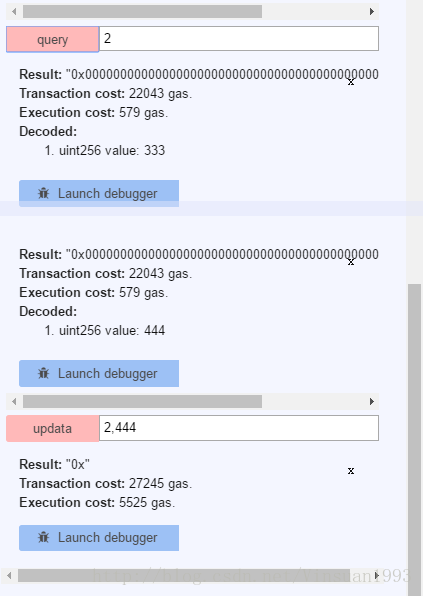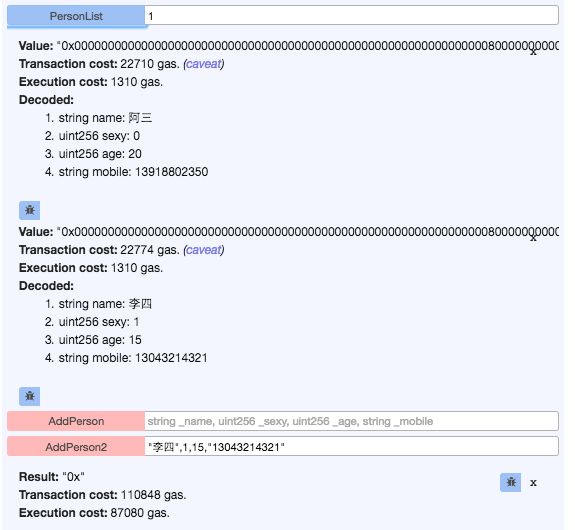solidity数据结构
一、Int类型
int & uint
int代表有符号的整型,也就是可以带负数
uint代表没有符号的整型,也就是从0开始的正整数
uint8 代表为2的8次方
uint256 代表为2的256次方
uint 默认为 uint256
int8 代表为-2的7次方到正2的7次方
int256 代表为-2的255次方,到正2的255次方;
int 默认为int256
整型操作符
二、数组类型comparisons: <=, <, ==, !=, >=, >
bit operator: &, |, ^,~
arithmetic operator: +, -, *, /, %, **, <<, >>
数组类型基础
- solidity语言中,int/uint 数组类型的定义方式如下:
uint[] a; int[] b; - 数组类型的成员有两个
length和push。- push 是给数组类型增加一个元素,同时该数组的长度+1
- length 返回当前数组的长度。有一个元素,则返回1,有两个元素则返回2.
从一个最简单的int数组合约开始,实现简单的增删改查
pragma solidity ^0.4.0;
contract aaa{
uint[] a;
function aaa(){
a.push(111);
}
function add(uint n){
a.push(n);
}
function lenof() returns(uint len) {
return a.length;
}
function updata(uint index,uint value ){
if(index > a.length -1) throw;
a[index] = value;
}
function query(uint index) returns(uint value){
if(index >= a.length) throw;
return a[index];
}
function del(uint index){
if(index >= a.length) throw;
for(uint i = index;i < a.length-1;i++){
a[i] = a[i+1];
}
delete a[a.length-1];
a.length --;
}
} 上面代码很简单,定义了一个public的int数组a, 以及一个方法add(uint a)等方法。
在browser-solidity中我们可以先add(111) & add(222). 然后调用a[0] & a[1],来查看结果。还有其它操作
结果显示如下图所示:

三、string类型
String数组类型定义
string[] strArr
String数组的增删改查
- Step 1: 首先撰写一个String数组的contract和构造函数
pragma solidity 0.4.10; contract Demo { string[] public strArr; function Demo() { strArr.push("init"); } } - Step 2: 添加一个Add function
function Add(string str) { strArr.push(str); } - Step 3: 添加一个Update function
function Update(uint index, string str) { if (index > strArr.length-1) throw; strArr[index] = str; }大家注意一下,如果index>strArr.length-1, 此时应抛出异常
- Step 4: 添加一个ValueOf function
function ValueOf(uint index) returns (string str){ if (index > strArr.length-1) throw; return strArr[index]; } - Step 5: 添加一个DeleteAt function
function DeleteAt(uint index) {
uint len = strArr.length;
if (index > len-1) throw;
for (uint i = index; iEnum类型定义
enum ActionCode {Left,Right, Forward, Rollback}
ActionCode public b2;
Enum的Demo代码
- Step 1: 首先定义enum类型
pragma solidity 0.4.7;
contract Demo {
enum ActionCode {Left,Right, Forward}
ActionCode public b2;
}
- Step 2: 设置一个构造函数,并给变量b2赋予一个初始值
function Demo() { b2 = ActionCode.Left; } - Step 3:设置一个判断函数,输出结果
function f() returns (string str) { if (b2 == ActionCode.Left) return "Left"; }
Step1-3的完整代码如下:
pragma solidity 0.4.10;
contract Demo {
enum ActionCode {Left,Right, Forward}
ActionCode public b2;
function Demo() {
b2 = ActionCode.Left;
}
function f() returns (string str) {
if (b2 == ActionCode.Left) return "Left";
}
}
Step 1-3,实现了enum(枚举)类型的功能,在构造函数中设置变量b2的初始值,然后根据b2的value来进行判断。
- Step 4: 在Step1-3的基础上 添加几个function。Left()/Right()/Forward()
function Left() { b2 = ActionCode.Left; } function Right() { b2 = ActionCode.Right; } function Forward() { b2 = ActionCode.Forward; } - Step 5: 修改f(), 增加两个输出
if (b2 == ActionCode.Right) return "Right"; if (b2 == ActionCode.Forward) return "Forward";
完整代码如下:
pragma solidity 0.4.7;
contract Demo {
enum ActionCode {Left,Right, Forward}
ActionCode public b2;
function Demo() {
b2 = ActionCode.Left;
}
function Left() {
b2 = ActionCode.Left;
}
function Right() {
b2 = ActionCode.Right;
}
function Forward() {
b2 = ActionCode.Forward;
}
function f() returns (string str) {
if (b2 == ActionCode.Left) return "Left";
if (b2 == ActionCode.Right) return "Right";
if (b2 == ActionCode.Forward) return "Forward";
}
}
以上完整的代码,实现了left(),right() & forward() 方法
五、struct类型Struct类型定义
例如定义一个struct类型的Person
struct Person {
string name;
uint sexy; //0: 男性;1:女性;
uint age;
string mobile;
}
建立一个Struct的Demo合约
- Step 1: 撰写最基本的合约
pragma solidity 0.4.10;
contract DemoTypes9 {
struct Person {
string name;
uint sexy; //0: 男性;1:女性;
uint age;
string mobile;
}
Person[] public PersonList;
}
最初的合约只定义了struct person类型,以及一个数组Person[] PersonList
- Step 2: 给构造函数中添加初始化代码
function DemoTypes9() { /*数组类型添加元素方式1*/ uint id = PersonList.length++; Person p = PersonList[id]; p.name = "阿三"; p.sexy = 0; p.age = 20; p.mobile = "13918802350"; }
Step 1-2后,完整代码如下:
pragma solidity 0.4.10;
/*演示一下结构,如何和数组类型结合,一起使用;*/
contract DemoTypes9 {
struct Person {
string name;
uint sexy; //0: 男性;1:女性;
uint age;
string mobile;
}
Person[] public PersonList;
function DemoTypes9() {
/*数组类型添加元素方式1*/
uint id = PersonList.length++;
Person p = PersonList[id];
p.name = "阿三";
p.sexy = 0;
p.age = 20;
p.mobile = "13918802350";
}
}
以上代码在Browser-solidity中的执行结果如下图所示:
- Step 3: 添加一个AddPerson function, 使用之前的数组类型使用过的push方法
function AddPerson (string _name, uint _sexy, uint _age, string _mobile) {
/*数组类型添加元素方式2*/
Person memory tmp;
tmp.name = _name;
tmp.sexy = _sexy;
tmp.age = _age;
tmp.mobile = _mobile;
PersonList.push(tmp);
}
Browser-solidity的执行情况如下:
- Step4: 上面的AddPerson() 有点长,下面有一个更简单的方法 AddPerson2()
function AddPerson2 (string _name, uint _sexy, uint _age, string _mobile) {
/*数组类型添加元素方式3*/
uint id = PersonList.length++;
PersonList[id] = Person({name: _name, sexy: _sexy, age: _age, mobile: _mobile});
}
AddPerson2() 的方法简洁了很多
Browser-solidity的执行情况如下
完整代码在下面:
pragma solidity 0.4.10;
/*演示一下结构,如何和数组类型结合,一起使用;*/
contract DemoTypes9 {
struct Person {
string name;
uint sexy; //0: 男性;1:女性;
uint age;
string mobile;
}
Person[] public PersonList;
function DemoTypes9() {
/*数组类型添加元素方式1*/
uint id = PersonList.length++;
Person p = PersonList[id];
p.name = "阿三";
p.sexy = 0;
p.age = 20;
p.mobile = "13918802350";
}
function AddPerson (string _name, uint _sexy, uint _age, string _mobile) {
/*数组类型添加元素方式2*/
Person memory tmp;
tmp.name = _name;
tmp.sexy = _sexy;
tmp.age = _age;
tmp.mobile = _mobile;
PersonList.push(tmp);
}
function AddPerson2 (string _name, uint _sexy, uint _age, string _mobile) {
/*数组类型添加元素方式3*/
uint id = PersonList.length++;
PersonList[id] = Person({name: _name, sexy: _sexy, age: _age, mobile: _mobile});
}
}




